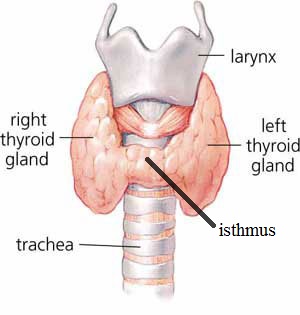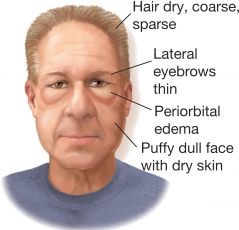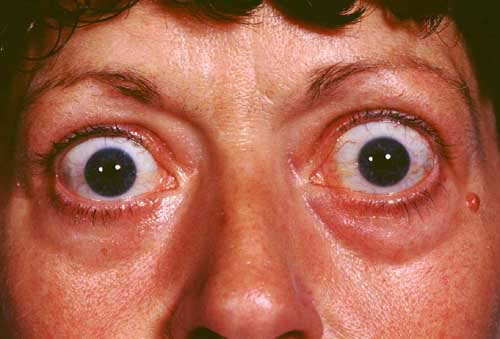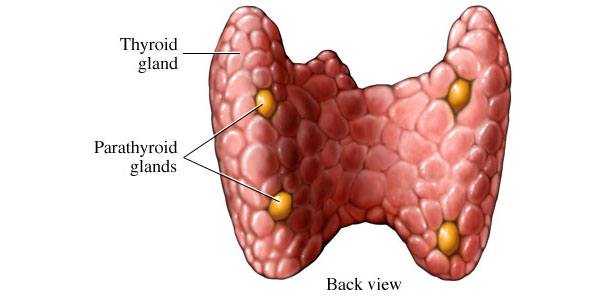
Thyroid and Parathyroid glands
Thyroid gland:
Location and structure:
- It is the largest endocrine gland located in the neck, anterior to the trachea.
- It consists of two lobes (left and right) connected by a tissue called isthmus and hence looks like a butterfly.
- Two types of cells make up the thyroid gland; the most prevalent but smaller follicular cells and the less plentiful but larger para-follicular cells.
- Follicular cells synthesize and secrete thyroid hormones (thyroxine and tri-iodothyronine).
- Para-follicular cells synthesize and secrete the hormone calcitonin.
- Thyroid gland is stimulated by thyroid stimulating hormone (TSH) released by adenohypophysis.

Functions of thyroid hormones:
- They accelerate cellular reactions and increase body metabolism.
- They increase the heart rate, cardiac output.
- They stimulate cellular differentiation and protein synthesis and affect the growth rate, water balance and several other physiological processes.
- They operate together with growth hormone from the pituitary to regulate overall growth and maturation including the development of nervous system.
Function of calcitonin:
- It lowers the calcium concentration in blood by directly acting on the bone cells for the reabsorption of access of calcium from the blood.
Because the thyroid hormones affect most cells of the body rather than a specific target area, the possibilities of malfunctions are far-reaching and can be serious.
Hypothyroidism (Under-secretion of thyroid hormones):
- Hypothyroidism causes the enlargement of the thyroid gland called simple goiter, prominently visible as a swelling in the neck which is due to the insufficient iodine in the diet.
- Under-activity of the thyroid during the development of the foetus after 12 weeks causes cretinism which is characterized by mental retardation and irregular development of muscles and bones.
- If the thyroid becomes underactive during adulthood, it results in myxedema producing swollen facial features, dry skin, low basal metabolic rate, tiredness, possible increased body weight etc.
- Other symptoms of hypothyroidism include decreased heart rate and blood pressure, lowered body temperature and under-activity of the nervous system.


Hyperthyroidism (Over-secretion of thyroid hormones):
- Nervousness, irritability, increased heart rate and blood pressure.
- Weakness, weight loss and high oxygen use even at rest.
- Exophthalmia (the bulging eyes), typical of hyperthyroidism is partly due to increased fluid behind the eyes.

Parathyroid glands:
Location and structure:
- The parathyroid glands are tiny lentil-sized, oval glands embedded in the posterior surface of the thyroid lobes.
- They are 4 in number, usually 2 glands in each lobe of thyroid.
- They synthesize and secrete the hormone, parathyroid hormone or parathormone.
- The adult parathyroid glands are composed mainly of small principal cells, which secrete most of the parathormone (PTH).
- Large oxyphilic cells secrete the reserve capacity of parathormone.

Functions of parathormone:
- It regulates the concentration of calcium (Ca2+) and phosphate in blood.
- When the concentration of calcium in the blood is low, parathormone increases the calcium level in several ways:
- It stimulates the activity of bone cells (osteoclasts), which break down bone tissue (osteolysis), releasing calcium ions from bones into the blood.
- It enhances the absorption of calcium from the small intestine into the blood. Adequate vitamin D is important for this process.
- It promotes the reabsorption of calcium by the kidney tubules so that the amount of calcium excreted in urine is decreased.
- It decreases the concentration of phosphate in the blood by inhibiting its reabsorption by the kidney tubules and thereby increasing its excretion in the urine.
Hypoparathyroidism (Under-activity of parathyroid glands):
- It results because of damage or accidental removal of parathyroid glands during surgery.
- The imbalance of calcium and phosphorus in blood because of hyperparathyroidism leads to faulty transmission of nerve impulses.
- It also leads to osteoporosis, hampered bone growth and paralysis of muscles (tetany).
*Muscle tetany is the periodic painful twitching or uncontrolled contraction of the skeletal muscles of the larynx, face, head and feet caused by the faulty calcium metabolism that is due to diminished function of the parathyroid glands.
Hyperparathyroidism (Over-activity of parathyroid glands):
- It leads to loss of appetite, nausea, weight loss.
- Kidney stones, duodenal ulcers, kidney failure, increased blood pressure and congestive heart failure.